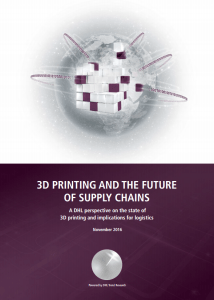
Katrina Megget writing for securingindustry.com has penned the following article which describes the significant strides which the 3D printing has made in recent times. Fears of a proliferation in ‘counterfeit production’ may just be arrested given developments which envisage the ‘embedding of digital rights’ into the 3D printing process.
3D printing has received an upgrade – it can now 3D print secure digital information such as QR codes, which could be used in anti-counterfeiting.
Introduced by Boston-based additive manufacturing firm Rize Inc, the development is the first example of Digitally Augmented Parts; essentially the printing of physical parts with digital information.
3D printing (also known as additive manufacturing), which produces a 3D object by depositing successive layers of a material on top of each other as directed by a computer-generated model, has become one of the fastest growing industries, extending into the toy, automotive, aerospace and medical device sectors, among others.
However, there are concerns that 3D printing could be a threat to brands and businesses through counterfeiting.
Rize’s technology directly addresses this concern by enabling a link between the physical 3D printed product and digital information, thereby integrating Industry 4.0 technologies such as blockchain, augmented reality and virtual reality.
According to the company, the “immutable connection…bridges the gap between the virtual and real world”.
Julie Reece, VP of manufacturing at Rize, explained the technique as embedding ‘Digital Rights Management’ into the functional 3D printed parts “for compliance, authenticity and traceability”.
“A significant challenge in the additive manufacturing industry are parts that are non-compliant due to design changes, piracy, counterfeit and obsolescence, that adversely impact the user and customer experience and result in rework, recalls and loss of brand value,” Reece told 3DPrint.com.
The technology expands on the company’s hybrid 3D printer that it introduced about two years ago. This combines two types of printing to form a multi-material technology that is called Augmented Polymer Deposition (APD), which has been used to make industrial-strength parts such as system components and medical testing equipment.
The enhancement now means 3D printed products can be embedded with secure digital information, such as in the form of a QR code. The QR code can then be scanned and read by a smartphone app, which relays the digital information, such as product, manufacturing and supply chain details, to the user.
Rize said the development is important for 3D parts and components used in more complex, multi-part products because it secures the supply chain and ensures authenticity.
“Additive is a part of a bigger strategy for many companies, which is a digital strategy or an Industry 4.0 strategy but really that digital strategy is not fully realised because when you print the part, the digital link breaks,” Andy Kalambi, president and chief executive of Rize, told TCT Magazine. “The moment the part gets printed on the machine it’s a physical part and there is no digital element left in it. The break of the digital link is a big issue for this industry overall to realise the promise of what is called Industry 4.0.”
On Rize’s website, Kalambi said: “This is the first step towards embedding intelligent capabilities within the part and connecting them through a digital thread into the digital twin of the part. Rize is leading the integration of additive manufacturing into the digital ecosystem, which will redefine the user and customer and experience, and ultimately scale the technology to an entirely new segment of commercial and industrial users.”
The development is a significant breakthrough for industry, which has previously voiced concerns that 3D printing will herald the production of counterfeit copies, emphasising the need for anti-counterfeiting measures.
Last May, scientists from the mechanical and aerospace engineering department at New York University noted there was a need to have anti-counterfeiting features within the computer-aided design model. They suggested a unique combination of processing and printing parameters built into the product’s digital design, which if stolen, would produce a defective product.
Other anti-counterfeiting features suggested for 3D printing include novel material compositions that cannot be easily replicated, or quantum dots, which are nanoparticles embedded in the 3D-printed object that can emit different wavelengths of light and provide a unique manufacturing signature.
Source: securingindustry.com, authored by K. Megget, 10 April 2018, [Picture: TCT Magazine]




You must be logged in to post a comment.